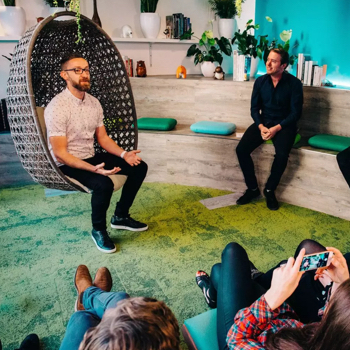Limbering up
Limbs & Things aims to improve patient outcomes through realistic learning experiences. Its founder, Margot Cooper, was recently named The National Business Awards 2018 Entrepreneur of the Year.
Inflexion has sponsored the National Business Awards ‘Entrepreneur of the Year’ Award since 2016. Focusing on the contribution of a dynamic, creative and visionary leader, the Award recognises an enterprising individual who has achieved sustained levels of growth and strong financial performance through a culture of innovation, resilience and an ethos of inspiring others through their leadership style.
The company is truly medtech at its best, although the term didn’t exist when Margot Cooper founded the business from her Bristol kitchen in 1990. Limbs & Things provides medical simulation to allow students to become competent and confident through practice with its products. Today the business generates over £18m in revenues through 90 global distributors and has subsidiaries in Australia, Sweden and the US.
Limbs & Things’ turnover has grown by more than 50% since 2015. This is impressive to say the least, as is the firm’s aim to launch two to three new products per year. In the last few years, new products include a complex abdominal examination model using palpation, auscultation and percussion as well as four add-on components for the firm’s very successful PROMPT birthing model.
Margot is the ultimate self-made super-woman. She grew up on a farm in Australia, and rather than go to university she worked and trained as a medical photographer in Melbourne. She moved to London in 1966 where she took up a medical art diploma based at the Royal Marsden, she then had four children in London before relocating to Bristol at the end of the 1980s. When her children were young, Margot made model commissions on a freelance basis, largely for pharmaceuticals businesses. “It worked well enough, but I felt my energy was better directed at training. So when we moved back to the UK, I began to make models for this purpose.”

The inspiration
“I had friends on the council of the Royal College of Surgeons and the Royal College of GPs who told me the direction the market was going, so I had conviction this could work. My market research made it clear that it was soft tissue that needed training on and that inspired my models for basic training.” Then in 1993, the General Medical Council published Tomorrow’s Doctors, which promoted medical training on simulation and was largely based on reducing junior hospital hours and preventing the misuse of tools due to insufficient training, thus decreasing the rising number of patient litigation.
“I looked across domestic and international markets but couldn’t find models which could represent the patient in a satisfactory way. I believed our models should be designed for a clinical or surgical task, or series of tasks as performed by a nurse, GP, surgeon, radiologist or paramedic. My objective was to work with the medical profession to establish training courses and use realistic part-task training models.”
But the medical community was largely unsupportive at first. “There were a handful of very excited professionals globally who were trumpeting this, but the majority of medics said, ‘we’ve done this for ages, why should we change now?’ I had to convince them.” Margot and her husband remortgaged their house to raise funds to employ talented sculptors to create what she envisaged. “That scenario is real chicken and egg – you know exactly what you’re meant to do but haven’t got the backing to do it. So we needed some capital to be able to hire staff.” It paid off and she managed to secure a number of significant patents.
While these helped with acceptance in the medical community, the research and trialing of the models was the next hurdle – a time consuming and expensive one. Bootstrapped from day one, Margot explains she had to draw on further funds before she could start generating revenues. “There was no market for such funding in those days; any VCs would want their money back in a few years and I knew that wasn’t going to happen.” While the landscape has changed, the business remains self-funded.
People power
She attributes much of Limbs & Things’ success to her staff: “Long standing employees have shown real determination and inspirational application; they are fascinated by the subject, the ethics and the sheer difficulty of our endeavour.” And Margot’s been their teacher. “With little precedent for our work and no training in the UK for medical sculpture, we ran courses using photographs, drawings, video and visits to theatre and the anatomy rooms. Now YouTube offers high quality imagery but ‘life reference’ remains vital.”
Staff turnover is low, and she is immensely proud of this. “We’ve got people that came straight out of school and are now in their 50s. We’ve got a sculptor who changed gears and went into marketing and now heads up new product development. To have been able to foster this is one of the greatest achievements of my life.”
Her advice for fledgling businesses?
You’ve got to see a way clear to having the financial backing you need, otherwise life becomes a great worry. This, along with building the market. If you’ve seen a gap, there isn’t necessarily a roaring trade there – otherwise somebody else would be doing it – so you need to allow time to build the market and build it properly so there aren’t holes to fall into. That takes time and finance. It needs to be long-term since if you have to pay money back when you can’t afford to, it’s difficult. When you’re attempting something which hasn’t been done before, there are a lot of false starts and you’ve got to keep going.
Contact



